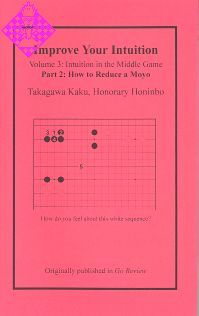Artikelnummer
LGTAKIYI03
Autor
Improve Your Intuition - Vol. 3
How to Reduce a Moyo
44 Seiten, Broschüre, Slate & Shell, 2000
Final vergriffen
Takagawa Kaku (1915-1986) was one of the dominant professional Go players in the middle of the twentieth century. His greatest achievement was winning the Honinbo title nine times in a row, 1952 through 1960, for which he was awarded the permanent title of Honorary Honinbo. Three of his books have been translated into English: How to Play Go (1956), The Vital Points of Go (1956), and The Power of the Star Point (1988). The first two have long been out of print, but they played a vital role in the development of Go in the West.
Improve Your Intuition is based on a series of articles Takagawa wrote for Go Review, an English language journal published by the Nihon Kiin (Japan Go Association) from 1961 through 1977 that was the primary source of information about Go in English during that period. These articles aim at providing an understanding of the basic principles of good play and will be useful even to beginners.
By "intuition" Takagawa means the ability to perceive basic features of the situation on the board without having to engage in reflective analysis to find them. This sort of ability is acquired through experience, but in order to have good intuition, we must have good experience. That is, our initial practice needs to be guided by correct principles. It is these principles that Takagawa was so skilled at laying out and clearly illustrating. His discussion of how to play correctly is lucid and precise. The principles are basic and widely applicable to common situations. This makes his lessons unusually valuable.
This first volume of Takagawa's lessons focuses on situations in the opening stage of the game. The second volume deals with patterns of attack and defense, and the third examines how to reduce a large moyo. The original articles have been slightly edited for these volumes, primarily by substituting English translations for some of the Japanese Go terms that were common in English writing about Go in those days. In these books, the only Japanese terms used, besides the name Go itself, which can be translated as "the surrounding game", arejoseki, meaning a pattern of play that gives equal results for both players, moyo, a large framework, atari, the condition of having only one liberty and hence being vulnerable to capture, sente, a play that maintains the initiative by requiring a local response, gate, a play that loses the initiative by not requiring a response, ho, a situation with the potential for repetitive recapturing, hane, a play that bends around in contact with an opponent's stone, and miai and ponnuki, which are explained in the text.
William Cobb December 2000, preface
Improve Your Intuition is based on a series of articles Takagawa wrote for Go Review, an English language journal published by the Nihon Kiin (Japan Go Association) from 1961 through 1977 that was the primary source of information about Go in English during that period. These articles aim at providing an understanding of the basic principles of good play and will be useful even to beginners.
By "intuition" Takagawa means the ability to perceive basic features of the situation on the board without having to engage in reflective analysis to find them. This sort of ability is acquired through experience, but in order to have good intuition, we must have good experience. That is, our initial practice needs to be guided by correct principles. It is these principles that Takagawa was so skilled at laying out and clearly illustrating. His discussion of how to play correctly is lucid and precise. The principles are basic and widely applicable to common situations. This makes his lessons unusually valuable.
This first volume of Takagawa's lessons focuses on situations in the opening stage of the game. The second volume deals with patterns of attack and defense, and the third examines how to reduce a large moyo. The original articles have been slightly edited for these volumes, primarily by substituting English translations for some of the Japanese Go terms that were common in English writing about Go in those days. In these books, the only Japanese terms used, besides the name Go itself, which can be translated as "the surrounding game", arejoseki, meaning a pattern of play that gives equal results for both players, moyo, a large framework, atari, the condition of having only one liberty and hence being vulnerable to capture, sente, a play that maintains the initiative by requiring a local response, gate, a play that loses the initiative by not requiring a response, ho, a situation with the potential for repetitive recapturing, hane, a play that bends around in contact with an opponent's stone, and miai and ponnuki, which are explained in the text.
William Cobb December 2000, preface
| Gewicht | 80 g |
|---|---|
| Hersteller | Slate & Shell |
| Breite | 13,5 cm |
| Höhe | 21,5 cm |
| Medium | Buch |
| Erscheinungsjahr | 2000 |
| Autor | Shukaku Takagawa |
| Sprache | Englisch |
| Seiten | 44 |
| Einband | Broschüre |
ii Preface
01 I. A Double Wing Moyo
06 II. A Knight's Move Moyo
08 III. A Large Knight's Move Moyo
10 IV. A Fourth Line Moyo
11 V. A One Space Jump Corner Enclosure Moyo
23 VI. A Knight's Move Corner Enclosure Moyo
27 VII. A Large Knight's Move Corner Enclosure Moyo
30 Whole Board Practice Tests
01 I. A Double Wing Moyo
06 II. A Knight's Move Moyo
08 III. A Large Knight's Move Moyo
10 IV. A Fourth Line Moyo
11 V. A One Space Jump Corner Enclosure Moyo
23 VI. A Knight's Move Corner Enclosure Moyo
27 VII. A Large Knight's Move Corner Enclosure Moyo
30 Whole Board Practice Tests

